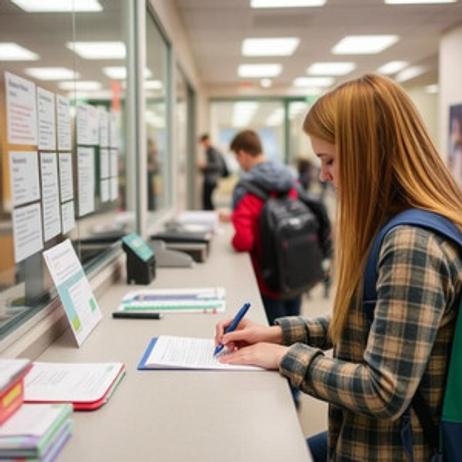How Documentation and Paperwork Can Block Access to Public Schools
Access to public education is foundational in democratic societies. Yet increasingly, families — especially those who are low-income, transient, or immigrants — face a formidable barrier: documentation and administrative paperwork. From proof of residency to immunization records, paperwork requirements are intended to streamline enrolment but often end up blocking access to public schools for the very students who need them most.
In 2025 this issue remains pressing: districts are still requiring extensive documentation, and research continues to demonstrate how these requirements disproportionately affect vulnerable students. This article explores how documentation requirements act as gatekeepers, why they persist, what the legal landscape reveals, and what effective practices look like for ensuring equitable access to public schools.
The Role of Documentation in School Enrollment
When families attempt to enrol a child in a public school, the school typically asks for documentation such as:
Proof of the child’s age (birth certificate or other valid record)
Transcript or prior school records (for transfers)
Immunization/health records
Proof of district residence (utility bill, lease, affidavit)
Guardianship or custody papers (if applicable)
Valid photo ID of the enrolling adult
On their face, these make sense: districts have obligations for attendance boundaries, health and safety, and record-keeping. But when the requirement becomes rigid, or when families cannot readily provide the documents due to transience, housing instability, language/cultural barriers, or immigration status, the result is exclusion or delay in enrolment.
A 2023 report in Atlanta found that families were required to produce “at least eight documents … twice as many as parents in New York City or Los Angeles”. The enforcement of these requirements can lead to children being kept out of school. AP NEWS
How Documentation Requirements Block Access: Key Mechanisms
1. Residency Proof & Attendance Boundaries
Many districts require families seeking to enrol in a given public school to prove they live within its attendance zone. Challenges arise when families:
Are living temporarily with relatives or friends (doubled up)
Are homeless or in shelters
Do not have a fixed address or utility bills
Are immigrants and rely on informal housing
Under the federal McKinney-Vento Act, children experiencing homelessness may enrol immediately without typical proof of residency.
Nevertheless, some districts’ documentation hoops still act as barriers.
2. Health / Immunization / Prior Records
Schools often delay or deny enrolment until immunization records, prior academic transcripts or health checks are submitted. For students who have moved frequently, are refugees, or come from under-resourced settings, retrieving these can be difficult.
Federal guidance warns that denying enrollment based solely on lack of health or immigration documentation is improper.
3. Immigration Status & Parental Documentation
Although federal law under the landmark Plyler v. Doe requires that children residing in the U.S. be granted access to public K–12 education regardless of immigration status, documentation demands can still deter families. Examples: schools requiring social-security numbers, green cards, or proof of parents’ legal status. That creates a climate of fear or exclusion.
4. Language, Cultural and Technology Barriers
Paperwork is often designed for mainstream families: English-only forms, complex language, online-only portals. Families who are immigrants, for whom English is not their first language, who lack reliable internet access, or who have limited literacy may struggle to complete the documentation. For example:
“A corrosive combination of onerous re-enrollment requirements, arcane paperwork and the everyday obstacles of poverty… is … preventing those children from going back.” — AP News
5. Administrative Discretion & Unintended Consequences
Even when documentation requirements are ostensibly neutral, they may have unequal impact. Research flags that families of colour, low-income families, and immigrant families are disproportionately affected by stringent documentation policies.
Who Is Most Affected?
| Group | Typical Documentation Barrier | Impact |
|---|---|---|
| Students experiencing homelessness or in transient housing | No utility bills / fixed address; delayed transcripts | May face delayed or denied enrolment, even though rights exist under McKinney-Vento. |
| Immigrant families / English-Learner households | Unfamiliar forms; questions about immigration status; lacking U.S birth certificate | Fear or avoidance of enrolment; potential discrimination. |
| Low-income families | Lack of access to internet or devices for online enrollment; no spare time or transportation to attend bureaucracy | Enrollment delays; fewer opportunities for school choice. |
| Students without prior records (e.g., refugee, migratory) | Missing transcripts, interrupted schooling | Difficulty placing the child in an appropriate grade or programme; may be held back or excluded. |
Legal Framework and Policy Context
The U.S. Supreme Court in Plyler v. Doe (1982) held that a state may not deny basic public education to any child residing in the state, regardless of legal immigration status.
The McKinney-Vento Act mandates that students experiencing homelessness must not be denied access to public education due to lack of fixed address, or records.
Federal guidance clarifies that schools may not request documentation whose purpose or effect is to discourage enrolment of immigrant or non-English speaking students.
Some districts have adopted “barrier‐free” enrollment policies (for example, the policy of the Vestavia Hills Board of Education explicitly stating that lack of birth certificate, immunization records, residency proof, or guardianship cannot delay enrollment of homeless, immigrant, or foster students.
In short: legally, schools must provide equal access to public education. But in practice, documentation requirements frequently act as de facto barriers.
Why the Problem Persists
Why do schools continue to impose documentation-heavy enrolment processes? Several reasons:
Risk management and accountability: Schools and districts use documentation (residency, health records, prior schooling) to ensure compliance with funding rules, programs, and state mandates (e.g., ensuring only local residents enrol).
Fraud prevention: Some policies are designed to prevent non-residents from enrolling, but the overcorrection affects legitimate families with non-traditional living situations.
Administrative convenience: Online portals, standardised forms and checklists lend themselves to requiring completed documentation upfront; incomplete forms can delay processes.
Lack of awareness or training: School staff may not be familiar with federal protections (McKinney-Vento, immigrant rights) and may apply documentation requirements rigidly.
Resource constraints: Districts may lack sufficient personnel or budget to work with families lacking documentation, interpret languages, or provide alternative pathways.
Because of these factors, documentation remains a bottleneck — even when the letter of the law supports immediate and uninterrupted access to public schools.
Addressing the Barrier: Best Practices for Schools & Families
For Schools and Districts
Adopt simplified enrolment policies:
Allow immediate provisional enrollment while documentation is secured.
Accept affidavits or declarations of residency instead of multiple utility bills.
Accept alternative proof of age when birth records are unavailable.
Remove immigration status as an enrolment barrier:
Ensure enrolment staff do not ask for citizenship, green card, SSN, or immigration status.
Provide multilingual, low-tech access:
Offer forms in multiple languages; offer paper as well as online enrolment; provide in-person or phone assistance for those without reliable internet or devices.
Train staff to handle exceptions:
Ensure staff understand rights under McKinney-Vento, know how to handle students lacking documents, and follow protocols for provisional enrolment.
Outreach and communication:
Communicate clearly to families that missing documentation will not block access, encourage early enrolment, and offer help acquiring records or completing forms.
Monitor enrollment data for equity:
Track whether certain student populations are under-enrolling or being delayed, and address administrative barriers accordingly.portal.ct.gov
For Families and Advocates
Understand your rights: children are entitled to public education regardless of address status, immigration status, prior records, or guardianship paperwork.
When confronted with paperwork barriers:
Ask for provisional enrolment immediately, and follow up on missing documents.
Seek assistance from school liaison for homeless students (McKinney-Vento), or from immigrant rights organisations.
Gather what you have (even informal letters or affidavits) and explain missing elements openly.
Keep copies of all submitted documents.
If you believe a school is unlawfully denying enrollment: you may contact state education agencies or the federal Office for Civil Rights. U.S. Department of Education
Case Example: The Hidden Impact in Practice
In the Atlanta metropolitan area, a 2023 feature documented how administrative and documentation hurdles have led to substantial numbers of children being effectively excluded from school. In the system studied, eight required documents were mandated for new enrollees — including notarised affidavits and social-security cards. Many families lacked stable housing or were “doubled-up” with friends and thus unable to produce conventional residency documents. The result: children missing from school rosters, delayed starts, and lost learning time.
This example illustrates how a process designed for order becomes a hurdle for equity — and helps explain why students from marginalized families are disproportionately impacted.
Why It Matters: Educational Equity and Access to Public Schools
Ensuring children can enrol in public schools without undue delay is not merely an administrative issue — it’s a matter of educational equity and civil rights. Delayed start dates or interrupted enrollment impact academic performance, social integration, and long-term outcomes.
Moreover, when documentation requirements disproportionately burden certain groups (immigrant families, low-income, homeless), these administrative barriers reinforce systemic inequities. As noted in recent civil-rights data, students from certain ethnic backgrounds, English learners, or with disabilities, often face lower access to educational opportunities. U.S. Department of Education
In this sense, tackling documentation-based barriers is a practical step toward ensuring that public schooling remains truly universal, accessible, and equitable.
Summary Table: Documentation Barriers vs. Inclusive Practices
| Documentation Requirement | Potential Barrier for Access | Inclusive/Alternate Practice |
|---|---|---|
| Proof of district residence (utility bills, lease) | Families in transient, shared or informal housing may lack such records | Accept affidavit plus supportive letter or shelter verification |
| Immunization/health records | Students from mobile or interrupted schooling may lack them | Enrol immediately and allow 30-60 days to obtain records |
| Prior school records / transcripts | Migratory, refugee or newcomer students often lack records | Place student appropriately and collect records retrospectively |
| Citizenship, social security, immigration paperwork | Immigrant families may fear disclosure or lack documents | Do not require; enrol based on address and age alone |
| Online-only enrolment portals | Families lacking internet or digital literacy get blocked | Offer paper enrolment, phone support, in-person assistance |
Looking Ahead: 2025 and Beyond
As we move deeper into 2025, two key trends demand attention:
Digital-first enrolment systems. While efficient for many, these systems can exclude those without reliable internet or tech access. It’s essential that district policy ensures alternative pathways remain for families facing the “digital divide.”
Increased mobility and housing instability. Economic pressures, climate events, pandemic after-effects and rental market instability means more families are doubling-up, changing residence mid-year, or facing homelessness. Schools must adapt enrolment practices accordingly to avoid losing students due to administrative gaps.
Finally, momentum for reform is growing: advocacy groups and legal firms are increasingly challenging districts that impose overly burdensome documentation requirements. In doing so they highlight the disconnect between policy and practice.
Conclusion
Administrative paperwork and documentation requirements are intended to ensure safe, orderly, lawful enrolment into public schools. Yet when implemented rigidly, they frequently become gatekeepers — blocking access to the public school system for children who are already vulnerable.
By understanding how documentation barriers operate, recognising which student populations are most affected, and adopting inclusive policies and practices, schools and districts can make meaningful progress toward ensuring that every child who is eligible can enrol and thrive in a public school.
For parents, students and educators, the takeaway is clear: being aware of rights, asking for provisional enrolment, and demanding clarity and flexibility in documentation can help reduce delays and exclusions. Ultimately, access to public schools must rest not on perfect paperwork but on practical pathways — because an education delayed is an opportunity lost.















